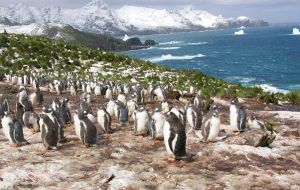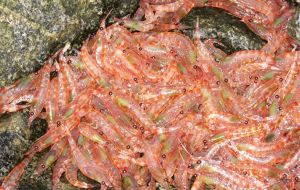MercoPress. South Atlantic News Agency
South Georgia gentoo penguins feed preferably on krill, shows 22 year BAS study
 The team, based at BAS, found that between 1989 and 2010 gentoo penguins ate approximately equal amounts of crustaceans, (mainly Antarctic krill) and fish. (Pic BAS)
The team, based at BAS, found that between 1989 and 2010 gentoo penguins ate approximately equal amounts of crustaceans, (mainly Antarctic krill) and fish. (Pic BAS)  Successful breeding was strongly related to the amount of krill in the diet, with few chicks fledging in years where krill was particularly scarce.
Successful breeding was strongly related to the amount of krill in the diet, with few chicks fledging in years where krill was particularly scarce. The longest and most comprehensive study to date of what penguins eat is published this month. The study, published in the journal Marine Biology, examines the diets of gentoo penguins (Pygoscelis papua) at Bird Island, South Georgia over a 22 year period and is part of a project investigating the Southern Ocean ecosystem and its response to change
Penguin parents forage at sea returning to feed their chicks every day. The team, based at British Antarctic Survey (BAS), found that between 1989 and 2010 gentoo penguins ate approximately equal amounts of crustaceans, (mainly Antarctic krill, a small shrimp-like creature) and fish.
Twenty-six different prey species were found in the diet, including squid, octopus and 17 species of fish. The composition of gentoo penguin diets was variable from year to year, with krill the dominant food in 10 years of the study and fish in 12 years. Successful breeding (the number of chicks fledged per nest per year) was strongly related to the amount of krill in the diet, with few chicks fledging in years where krill was particularly scarce.
The team then compared the diets of gentoo penguins with those of macaroni penguins (Eudyptes chrysolphus) also resident at Bird Island. Both species are able to switch to other prey when krill availability is low. However, where gentoo penguins have a broad and variable diet, macaroni penguins are specialist predators on krill. Their differing diets and foraging ranges allow the two penguin species to successfully coexist at Bird Island, South Georgia.
Lead author, Dr Claire Waluda, penguin ecologist at BAS says: “Gentoo and macaroni penguins are important indicator species and monitoring changes in their diets can help us understand changes in the Southern Ocean ecosystem.”
“This work highlights the importance of long-term data collection and supports the work of the Commission for the Conservation of Antarctic Marine Living Resources (CCAMLR), which is responsible for setting catch limits for commercial krill and fish in the Southern Ocean. Their aim is to protect marine ecosystems and maintain sustainable levels of fishing in this region.”
The paper summarises one of the longest time series of penguin diet currently available globally. Long-term variability in the diet and reproductive performance of penguins at Bird Island, South Georgia by Claire M. Waluda, Simeon L. Hill, Helen J. Peat and Philip N. Trathan is published this month in the journal Marine Biology.




Top Comments
Disclaimer & comment rulesCommenting for this story is now closed.
If you have a Facebook account, become a fan and comment on our Facebook Page!